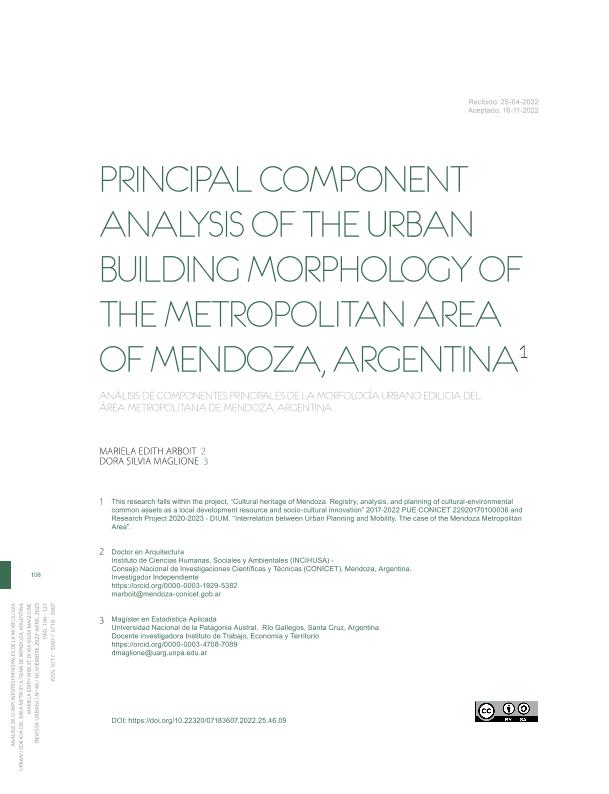Artículo
Cities located in arid areas are facing several risks that threaten their sustainability due to the effects of climate change and urbanization, and the resulting consumption inequality and depletion of natural resources. There are many variables that determine the urban-building form, which, in turn, affects energy consumption in cities. Therefore, the goal of this work is to condense the information provided by the urban-building morphological variables into just a few variables or combinations for the urban blocks located in the six departments of Mendoza’s Metropolitan Area (MMA). Methodologically, quantitative data of the spatial distribution of urban-building variables were considered, their correlations were calculated, and a Principal Component Analysis was applied to synthesize the number of variables. The results identify the Building Density, Building Separation, and Normalized Difference Vegetation Index (NDVI) as the main variables of the first principal component, in five of the six departments of the MMA. The first two are related to the built environment, and the third is to vegetation. By including data on urban tree cover, available only for the Capital department, the results include the tree-cover magnitude, completeness, and transmissivity variables, together with those already identified in the first three components. The findings of the work provide information on the representative urban-building variables of the oasis city that will allow, in the future, establishing intervention priorities considering a reduced number of synthetic variables, to propose efficiency and energy generation strategies. Las ciudades insertas en zonas áridas afrontan una serie riesgos que amenazan su sostenibilidad, al ser impactadas por los efectos del cambio climático y la urbanización, y consecuente inequidad de consumos y agotamiento de los recursos naturales. Existen muchas variables que determinan la forma urbano-edilicia, las que a su vez influyen en el consumo de energía en las ciudades. Por ello, el objetivo de este trabajo es condensar la información aportada por las variables morfológicas urbanoedilicias en solo algunas variables o combinaciones de ellas para las manzanas urbanas ubicadas en los seis departamentos del Área Metropolitana de Mendoza (AMM). Metodológicamente, se computaron datos cuantitativos de la distribución espacial de las variables urbano-edilicias, se calcularon sus correlaciones y se aplicó un análisis de Componentes Principales para sintetizar la cantidad de variables. Los resultados identifican como principales variables de la primera componente principal -en cinco de los seis departamentos del AMM- a la densidad edilicia, la separación edilicia y el Índice de Vegetación de Diferencia Normalizada (NDVI); las dos primeras relacionadas al ambiente construido y la tercera, a la vegetación. Al incorporar datos del arbolado urbano disponibles solo para el departamento de Capital, los resultados incluyen las variables magnitud, completamiento y trasmisividad del arbolado, junto a las ya identificadas en las primeras tres componentes. Los hallazgos del trabajo brindan información sobre las variables urbano-edilicias representativas de la ciudad oasis que permitirán a futuro establecer prioridades de intervención considerando un número reducido de variables sintéticas, a fin de proponer estrategias de eficiencia y generación energética.
Principal component analysis of the urban building morphology of the metropolitan area of Mendoza, Argentina
Título:
Análisis de componentes principales de la morfología urbano edilicia del área metropolitana de Mendoza, Argentina
Fecha de publicación:
12/2022
Editorial:
Universidad del Bío Bío
Revista:
Urbano
ISSN:
0717-3997
Idioma:
Inglés
Tipo de recurso:
Artículo publicado
Clasificación temática:
Resumen
Archivos asociados
Licencia
Identificadores
Colecciones
Articulos(INCIHUSA)
Articulos de INST. DE CS. HUMANAS, SOC. Y AMBIENTALES
Articulos de INST. DE CS. HUMANAS, SOC. Y AMBIENTALES
Citación
Arboit, Mariela Edith; Maglione, Dora Silvia; Principal component analysis of the urban building morphology of the metropolitan area of Mendoza, Argentina; Universidad del Bío Bío; Urbano; 25; 46; 12-2022; 106-121
Compartir
Altmétricas




